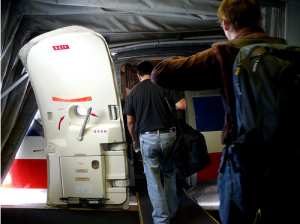Even Astrophysicists Can’t Figure Out How To Make Flight Boarding Process Less Nightmarish
There are some people out there who are just so freaking smart it’s almost shocking when even they can’t begin to understand the most frustrating things in life. Like the process of herding passengers onto an airplane, an operation that at its most basic includes putting one foot in front of the other and stowing bags. But it’s so dang complicated, even an astrophysicist says he can’t figure out how to make the boarding line a less awful experience.
You’ve got your creeper passengers, those who nudge forward ever so slightly until their group boards, or those who ditch all the rules and barge into line with no regard for boarding groups. And often, airline attendants aren’t about to call those rude folks out, causing fellow passengers to silently seethe and wish to high heaven that there’s still overhead bin space.
The Associated Press spoke to astrophysicist, Jason Steffen of the University of Illinois who got fed up with all the rigmarole and hullabaloo and bent his braininess toward solving the myriad issues of airplane boarding.
“I thought there had to be a better way,” he says.
Using all the mathiness at his disposal, he found that the best way to do it is filling window seats first, then working in from there, while spacing boarding passengers two rows apart. But alas — getting passengers to board so precisely is as easy as herding cats.
“Well,” Steffen observes, “I understand why airline people aren’t calling me.”
Airlines have been trying to work out the best way to fill planes up, which is in the interest of both their businesses (a late plane is a pricy plane) and the customers angling to get seated and settle in before a flight. And also, to make sure those roller bags will be stowed.
Southwest Airlines lets passengers figure out where they want to sit and instead charge extra to be in the front of the boarding line, while American Airlines has just started allowing fliers with only one personal item and no carry-ons to board first. That process has trimmed boarding by two minutes per flight, says an airline rep.
United has downsized its boarding groups from seven to five and added lanes in the gate areas to cut down on “gate lice” — those antsy people who gum up the works by lurking near the line before their group is called to board.
And then there’s Spirit, which cuts down on boarding time by charging fees for carry-on bags, something other airlines aren’t likely to do for fear of ticking off fee-fatigued customers.
Of course, there are those of us who would rather just check a carry-on at the gate and get on board sooner.
“Why not?” says one traveler. “There won’t be room for the bag (in the overhead bin) anyway.”
Not that I know better than an astrophysicist (my degree was only in regular physics with a focus on Super Hard Math Stuff, obviously), but perhaps some kind of hybrid model combining Southwest’s assigned boarding order numbers, but with pre-assigned seats. But again, herding cats who don’t want to listen to the rules of airline boarding makes any efficient, logical idea almost impossible.
Keep crunching those numbers, smart people. Something’s gotta work or I will seriously lose my cool the next time a Group 4 person sneaks ahead of me and boards in Group 2. You know who you are.
The Airlines’ Endless Quest for Better Boarding [Associated Press]
Want more consumer news? Visit our parent organization, Consumer Reports, for the latest on scams, recalls, and other consumer issues.


